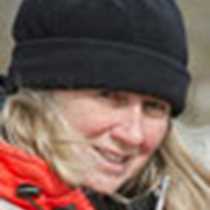Petersburg, Alaska
A rainbow at midnight? Was this a strange dream or did we really hear these words spoken from the bridge? We were expecting and anticipating another aurora borealis display but a rainbow is generally not a phenomenon of the darkness of the night. The invitation needed investigation and once again we gathered on the foredeck forsaking our warm and cozy beds. The form and figure were there. A perfect arc stretched from silhouetted mountain to another shadowed shore. But instead of the colors of the spectrum, lemon yellow was the hue. Reflected in the dark still water it fashioned an ovoid shape sprinkled in the center with glimmering stars. Magnetic north was the pivot point. Strange fingers appeared cutting Ursa Major from its tail. Curtains dropped towards the darkened stage of earth. The show played to a full house of stars and planets.
By morning there was no sky. In fact there appeared to be no land, just a veil of mist through which the foghorn wailed. As wake-up activities prevailed, the ship quietly slithered into the convoluted harbor in Petersburg at the northern edge of Mitkof Island. Fishing boats sat silently in the berths, their specialized rigging reflected in the sea. Only the call of gulls rang out mingling with the building murmur of raindrops splashing against the water’s surface tension and sending rippling rings to coalesce with those created by their neighbors. They pattered on our hoods and dripped off our hat brims but they were soon forgotten as we immersed ourselves in the mysterious world of the muskeg.
Tannic rivulets collected between hummocked sphagnum moss. Water striders skated on ponded streams. They danced around three leafleted bog bean anchored like navigational aids directing their paths. Pale green fruticose lichens dripped from contorted branches of shore pine and graceful limbs of cedar. Their ghostliness was echoed on the land by reindeer moss delicately growing between miniscule conifer-like branches of crowberry and berry laden bog blueberry. Standing in water but starving for a fresh drop to drink, plants adopted desert forms. Linear leathery leaves rolled their edges under protecting evaporative surfaces and preventing moisture loss. Lacking in nutrition, stunted growth became the norm reserving energy for only flowers and fruit to pass their genes along. Carnivorous tendencies developed too. Tiny sundews set tempting traps for insects in search of nectar and then sucked their bodies dry to fulfill nitrogenous needs. It was an eerie land, a sharp contrast to the lushness of the encircling forest where trees stood tall, shrubs were thick and green and moss carpets sported patterns of leaves of herbaceous plants and fronds of ferns.
Red and green lights, cans and nuns, triangular and square symbols directed our route south through Wrangell Narrows. Sumner Strait led to Clarence Strait. The urge has given way to action. As the leaves of Alaska’s devil’s club turn to red and golden, our migration couples with the flight of accompanying jaegers. Dozens of eagles stand on the shores and perch in the trees, an audience for killer whales and leaping salmon. All are intent upon their lives unaware or uncaring that we are watching and that we are saying goodbye for another year. Southbound, we proceed on.




